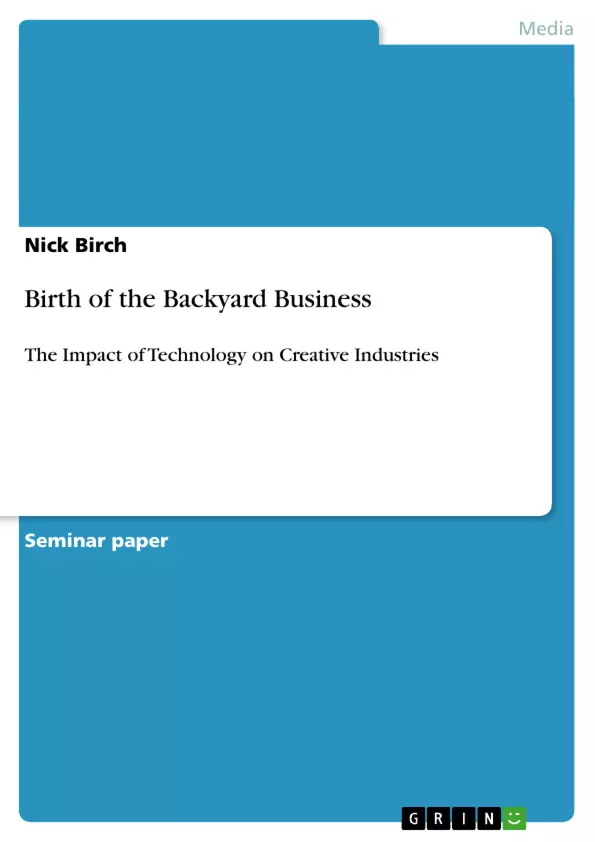Technology is evolving faster than we can shake an iPod at, and like a frenetic silhouette on a primary-coloured backdrop it is difficult to see the entire picture – you are only left with a gist of what on earth is actually going on, a feeling that you want to jump up and be a part of it. Even though it helps to analyse the progress of technology in the creative fields historically, it still remains implausible to predict exactly where it will take us even in the near future. The film, television and music industries are an interesting source to start with where we may begin to understand some of the ways technology is not only enhancing the ability to create more, but also the way it affects the way business is performed.
Inhaltsverzeichnis (Table of Contents)
- Introduction
- The Impact of Technology on Creative Industries
- The Rise of "Backyard" Businesses
- The Role of Talent
- The Internet and the Democratization of Creativity
- The "Amateurisation" of Creative Industries
- Conclusion
Zielsetzung und Themenschwerpunkte (Objectives and Key Themes)
This text examines the impact of technology on creative industries, specifically focusing on the film, television, and music industries. It explores how advancements in technology have changed the way these industries operate, create content, and conduct business. The author argues that while technology has lowered barriers to entry and democratized creativity, it has also presented new challenges and opportunities for professionals in these fields. Here are some of the key themes explored:- The rise of "backyard" businesses and the impact of technology on cost and accessibility
- The importance of talent in the face of readily available technology
- The democratization of creativity and the challenges of copyright protection
- The "amateurisation" of creative industries and the rise of online platforms for distribution
- The need for innovation and adaptation in the face of technological change
Zusammenfassung der Kapitel (Chapter Summaries)
The introduction sets the stage by discussing the rapid evolution of technology and its profound impact on creative industries. It highlights the difficulty in predicting the future trajectory of technology in these fields.
The chapter titled "The Impact of Technology on Creative Industries" delves into the specific ways technology has revolutionized filmmaking, television production, and music creation. It examines how the advent of digital technology, such as High-Definition video and software editing programs, has lowered costs, increased accessibility, and changed production workflows. The author also explores the rise of "backyard" businesses and the challenge of competing with lower overheads.
The next chapter, "The 'Amateurisation' of Creative Industries," explores the democratization of content creation through platforms like the internet, blogs, and file-sharing services. The author examines the implications of this shift for professional creatives and the potential for "failure" in an environment where anyone can publish their work. The chapter also discusses the role of platforms like Google in filtering and highlighting quality content in an increasingly saturated market.
The text concludes with a discussion about the need for adaptation and innovation in creative industries. The author argues that while technology has changed the way creative content is produced and distributed, the fundamental value of talent and quality remains paramount.
Schlüsselwörter (Keywords)
This text explores the impact of technology on creative industries, focusing on themes such as the democratization of creativity, the rise of "backyard" businesses, the importance of talent, and the challenges of copyright protection in a digital age. It also examines the role of platforms like the internet, blogs, and file-sharing services in the distribution and consumption of creative content. Keywords include technology, creative industries, film, television, music, "backyard" businesses, talent, amateurisation, copyright, digital technology, internet, file-sharing, distribution, platforms, Google, and innovation.- Quote paper
- Nick Birch (Author), 2009, Birth of the Backyard Business, Munich, GRIN Verlag, https://www.grin.com/document/269614



